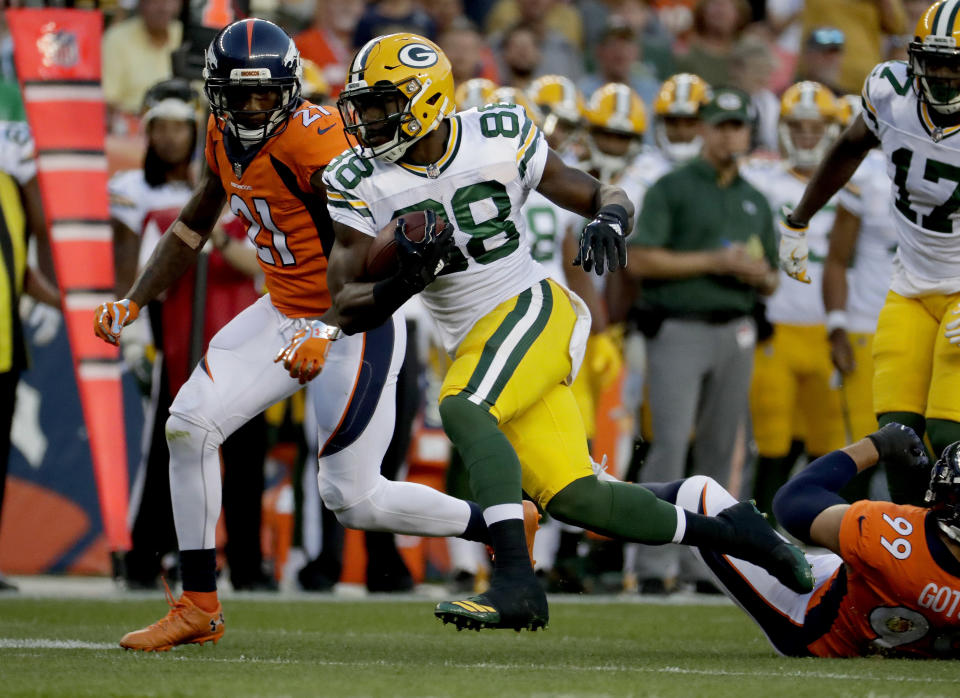Juggernaut Index, No. 3: Aaron Rodgers is still unfair

In the unlikely event that you need a reminder of Aaron Rodgers’ place among the NFL’s best quarterbacks, here’s a list of categories in which he now ranks first all-time:
• Passer rating, 104.1
• Interception rate, 1.5 percent
• Adjusted yards per pass attempt, 8.49
• Adjusted net yards per pass attempt, 7.48
[Now’s the time to sign up for Fantasy Football! Join for free]
Again, those are the areas in which he is the best to ever play the game. Rodgers also ranks top-10 all-time in completion percentage (65.7), passing yards per game (259.3), yards per pass attempt (7.9) and touchdown rate (6.4). He’s ranked either first or second at his position in fantasy scoring in seven of the past nine years, which is just silly. He hasn’t thrown double-digit interceptions since 2010, a season that ended with his team winning the Super Bowl.
If you don’t have Rodgers at the top of your quarterback ranks for 2017, then I would respectfully say that your ranks are trash. He led the league in TD passes last season with 40, then tossed another nine over three playoff games.
As a lifelong Bears fan, it gives me no pleasure to report that Rodgers is basically as good at his job as anyone has ever been at anything. I was sick of him before he was even a thing, but it’s impossible not to respect his talent and inventiveness. Rodgers has a huge arm and freakish accuracy, whether he’s on the move or throwing from a quiet pocket. As an added bonus, he’s also averaged 5.1 YPC for his career and rushed for 25 scores over the past nine seasons. He has continuity in his receiving corps, too.
Will age finally catch up to Jordy Nelson?
Eventually, sure, Jordy will decline. But at the moment he’s a healthy 32-year-old receiver coming off a year in which he caught 97 balls for 1257 yards and 14 touchdowns. It was his third season with double-digit TDs and his fourth with at least 1200 yards. Nelson ranked sixth in the league in total targets (152) and first in red-zone chances, by a mile (32). He also led the NFL in targets inside the 10 and 5-yard lines (15, 9). Jordy remains the top option in the most important area of the field for the league’s top passer. So yes, he deserves his early second round ADP (13.5).

Davante Adams actually tied for second in red-zone targets among all receivers last year (23), which tells us that A) Green Bay scores lots of points, and B) Adams is well within Rodgers’ circle of trust. These are very good things. Adams has been drafted as a WR2 (ADP 42.7), and he’s earned his status. He’s coming off a 997-yard, 12-touchdown season. Adams doesn’t have the game’s best hands, but the half-dozen or so drops he might produce over the course of a season is more than offset by the greatness of his QB. We can’t guarantee that Adams will perfectly reproduce last year’s stats, but he’s a good bet for at least eight scores.
[Pick one winner a week. Play Survival Football for chance at $100K]
Randall Cobb remains in the mix entering his age-27 season, though his numbers have slipped in back-to-back years. He was a regular on the injury report in 2016, ultimately hauling in just 60 passes for 610 yards on 84 targets. Nelson and Adams each saw significantly more red-zone targets than Cobb (14), and we have no reason to think that won’t continue. Cobb will deliver the occasional big game when Rodgers decides to undress a specific opposing corner, but he enters the season essentially as a low-end WR3 with plausible upside. He needs to be owned somewhere, but he clearly isn’t an auto-start.
The top-three receivers on this team are so firmly established that Geronimo Allison and Jeff Janis have no realistic path to fantasy value, except via injury. Green Bay’s tight ends, however, could get fun. The Packers added Martellus Bennett in the offseason, and, despite the fact that he doesn’t care about your fantasy team, he can certainly help it. Bennett is a proven fantasy asset who just produced a 701-yard, seven-TD season for New England. He’s an excellent all-around tight end and unquestionably an upgrade from Jared Cook.
Lance Kendricks was added as well, but Bennett is clearly the guy to target. Green Bay tight ends were targeted 102 times last season, so there’s enough volume here to support an ownable fantasy starter. It’s possible that Bennett will poach red-zone chances from Nelson, Adams and Cobb, but, again, this is an offense that spits out yards and points like few others.

Ty Montgomery is apparently going to revolutionize his position.
No, that’s a joke. I do not actually think Montgomery is going to revolutionize any position. He was very good last season (5.9 YPC) on relatively few touches (77 carries, 44 REC), and many fantasy analysts are playing a dangerous game of extrapolation. We should never assume that a player can double his workload and remain every bit as productive on a per-touch basis. Montgomery only handed double-digit carries once last season, and he dealt with issues related to the sickle cell trait. He also delivered 222 of his 457 total rushing yards against Chicago’s defense, most of them in a frigid game in which Christine Michael gashed them, too (4 carries, 45 yards, TD).
Bottom line, Montgomery is a good player in a great offense, but he’s far from a proven featured runner. I’ve seen him drafted in crazy spots by people who are apparently banking on a sizable workload and a zillion scrimmage yards. We’ll see. This is not a situation in which I’m willing to pay the expectant price, to borrow a Pianowskiism. I have far more shares of Jamaal Williams, a capable-if-unspectacular fourth round rookie out of BYU. Williams has run as the clear No. 2 back, and pass-protection is among his strengths. (Some might argue it’s his only obvious strength; I’m not claiming he’s a star.) If Montgomery breaks out in a big way, he won’t be my success story. I’d feel better about him in PPR, but someone always beat me to him in those drafts, too.
Green Bay’s defense isn’t an early season option.
This team opens with Seattle, then travels to Atlanta, and then hosts Cincinnati. Surely you can find better options in Weeks 1-3. Green Bay finished dead-last in the league in terms of Y/A allowed last season (8.1) and next to last in total passing yards (269.3 YPG). The Packers weren’t so dreadful against the run (4.0 YPC allowed), but this is not really a lock-down defense in any area. Green Bay is only to be used when the matchup demands it (vs. Chicago in Week 4, at Cleveland in Week 14).
2016 Offensive Stats & Ranks
Points per game – 26.3 (5)
Pass YPG – 226.9 (23)
Rush YPG – 149.8 (2)
Yards per play – 6.0 (4)
Plays per game – 63.2 (19)
—
Previous Juggernaut Index entries: 32) NY Jets, 31) San Francisco, 30) Cleveland, 29) LA Rams, 28) Baltimore, 27) Chicago, 26) Minnesota, 25) Detroit, 24) Denver, 23) Jacksonville, 22) Buffalo, 21) Philadelphia, 20) Miami, 19) Indianapolis, 18) Kansas City, 17) Washington, 16) NY Giants, 15) Tennessee, 14) LA Chargers, 13) Carolina, 12) Houston, 11) Arizona, 10) Oakland, 9) Tampa Bay, 8) Cincinnati, 7) New Orleans, 6) New England, 5) Seattle, 4) Dallas, 3) Green Bay



